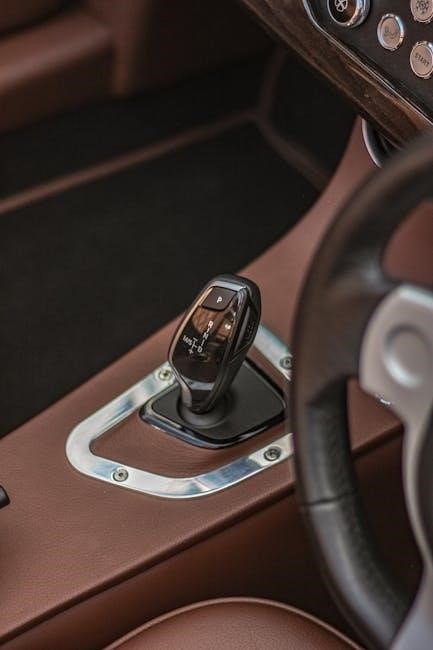Understanding the differences between auto-ranging and manual multimeters is essential for selecting the right tool for electrical measurements. This guide compares their functionality‚ accuracy‚ and practical applications‚ helping professionals and beginners make informed decisions for their specific needs.
Overview of Multimeters
Multimeters are versatile tools used to measure electrical properties like voltage‚ current‚ and resistance. Available in analog and digital forms‚ they are essential for diagnosing and troubleshooting electrical circuits. Modern multimeters often feature auto-ranging or manual-ranging capabilities‚ each offering distinct advantages. Auto-ranging multimeters automatically adjust the measurement range‚ providing ease of use‚ while manual-ranging models require users to set the range themselves‚ offering precision for experienced professionals. Understanding these differences is crucial for selecting the right multimeter for specific tasks‚ ensuring accuracy and efficiency in various applications‚ from DIY projects to industrial settings.
Understanding Auto Ranging and Manual Ranging
Auto-ranging multimeters automatically select the appropriate measurement range‚ ensuring accurate readings without manual adjustment. This feature is ideal for beginners or situations where the expected value is unknown. Manual-ranging multimeters require users to set the range themselves‚ offering precise control for professionals who understand the expected measurement range. While auto-ranging provides convenience and speed‚ manual-ranging offers better accuracy and control for specific tasks. Both methods cater to different user needs‚ with auto-ranging prioritizing ease and manual-ranging emphasizing precision and expertise.
Importance of Comparing Auto Ranging and Manual Ranging Multimeters
Comparing auto-ranging and manual-ranging multimeters helps users choose the right tool for their needs. Auto-ranging offers speed and simplicity‚ ideal for quick measurements and everyday tasks. Manual-ranging provides precision and control‚ suitable for professionals requiring accurate readings. Understanding these differences ensures optimal performance and cost-effectiveness‚ whether for DIY projects or industrial applications. This comparison also highlights scenarios where one type may outperform the other‚ guiding users to make informed decisions and avoid potential errors in measurement. Proper selection enhances efficiency and reliability in various electrical and electronics tasks.

What is an Auto Ranging Multimeter?
An auto-ranging multimeter automatically adjusts its measurement range for optimal accuracy‚ eliminating manual selection. It simplifies use‚ offering quick‚ precise readings with minimal user input required.
Definition and Functionality
An auto-ranging multimeter is a versatile tool that automatically selects the appropriate measurement range for voltage‚ current‚ resistance‚ or other electrical parameters. This eliminates the need for manual range selection‚ providing convenience and reducing setup time. The device adjusts its range dynamically based on the input signal‚ ensuring accurate and optimized readings. Its functionality includes automatic scaling‚ which prevents overrange errors and enhances measurement precision. This feature is particularly beneficial for users who may lack expertise in manual range adjustment‚ making it ideal for beginners and professionals seeking efficiency in diverse electrical applications.
How Auto Ranging Works
Auto-ranging multimeters operate by automatically adjusting their measurement range based on the input signal’s magnitude. When a measurement is initiated‚ the device quickly assesses the input and selects the most suitable range to ensure optimal resolution and accuracy. This process is typically seamless‚ occurring in milliseconds. The multimeter’s internal circuitry continuously monitors the input and dynamically adjusts the range as needed‚ even during ongoing measurements. This capability eliminates the risk of overrange errors and ensures precise readings without user intervention‚ making it a time-saving feature for both professionals and hobbyists in various electrical applications.
Advantages of Auto Ranging Multimeters
Auto-ranging multimeters offer unmatched convenience and efficiency. They eliminate the need for manual range selection‚ saving time and reducing the risk of human error. With auto-ranging‚ the device automatically adjusts to the optimal measurement range‚ ensuring precise and accurate readings. This feature is particularly beneficial for beginners‚ as it simplifies operation and minimizes the learning curve. Additionally‚ auto-ranging multimeters are versatile‚ adapting seamlessly to various measurement scenarios‚ from low to high voltages; Their ease of use and adaptability make them ideal for professionals and hobbyists alike‚ especially in dynamic environments where quick and accurate measurements are critical.

Common Applications of Auto Ranging Multimeters
Auto-ranging multimeters are widely used in various fields due to their versatility and ease of use. They are ideal for DIY projects‚ where quick and accurate measurements are essential. In automotive repair‚ they simplify troubleshooting electrical systems. Professionals rely on them for industrial settings‚ ensuring efficient diagnostics. Additionally‚ auto-ranging multimeters are popular in educational environments‚ helping students learn electrical concepts without the complexity of manual adjustments. Their adaptability makes them a preferred choice for general-purpose electrical work‚ ensuring precise measurements across diverse applications.

What is a Manual Ranging Multimeter?
A manual ranging multimeter requires users to set the measurement range themselves‚ offering precision and control for specific tasks‚ ideal for professionals needing accuracy in detailed diagnostics.
A manual ranging multimeter operates by requiring users to manually select the appropriate measurement range for the desired reading. This process involves choosing from predefined ranges for voltage‚ current‚ or resistance to ensure accurate measurements. Unlike auto-ranging models‚ manual multimeters do not automatically adjust the range‚ giving users more control over the measurement process. This functionality is particularly useful in scenarios where precise measurements are critical‚ as it allows for tailored settings based on the specific task. However‚ it demands a higher level of user expertise to select the correct range effectively.
How Manual Ranging Works
Manual ranging requires users to select the appropriate measurement range using a dial or buttons on the multimeter. This involves choosing from predefined ranges for voltage‚ current‚ or resistance. For example‚ selecting 2kΩ or 10mA ensures the device measures within that specific range. The user must know the expected value range of the measurement to avoid overloading the circuit. If the selected range is too low‚ the multimeter may display an overload error. Correct range selection is crucial for accurate readings and to prevent damage to the device.
Consulting the multimeter’s specifications or having prior knowledge of the circuit is essential for proper functionality.
Advantages of Manual Ranging Multimeters
Manual ranging multimeters provide precise control over measurement ranges‚ ideal for professionals needing exact readings in industrial or high-stakes settings. They offer reliability in high-precision environments and reduce the risk of errors compared to auto-ranging models. Additionally‚ manual multimeters are often more cost-effective and durable‚ as they lack complex electronics‚ making them a practical choice for those who value accuracy and longevity without the need for advanced features.
Common Applications of Manual Ranging Multimeters
Manual ranging multimeters are widely used in industrial electronics‚ laboratory settings‚ and field service work where precise control and accuracy are critical. Professionals often rely on them for troubleshooting complex circuits and high-precision measurements. In industrial environments‚ they are preferred for their reliability and ability to maintain consistent range settings. Additionally‚ manual multimeters are ideal for educational purposes‚ as they help students understand the fundamentals of measurement ranges. Their durability and simplicity make them a practical choice for repetitive tasks and environments where advanced features are unnecessary.

Auto Ranging vs Manual Ranging Multimeters
Auto ranging offers speed and convenience‚ while manual ranging provides precision and control‚ catering to different user preferences and professional needs.
Key Differences Between the Two
The primary distinctions lie in functionality and user input. Auto-ranging multimeters automatically select the optimal measurement range‚ offering convenience and faster readings. In contrast‚ manual-ranging models require users to set the range themselves‚ providing greater control for precise measurements. Auto-ranging is ideal for beginners or quick tasks‚ while manual-ranging suits professionals needing accuracy. Additionally‚ manual models often lack the complexity of auto-ranging‚ potentially reducing costs. Each type caters to different skill levels and use cases‚ making the choice dependent on individual needs and preferences.
Measurement Speed and Accuracy
Measurement speed and accuracy are critical factors when comparing auto-ranging and manual multimeters; Auto-ranging multimeters automatically adjust to the optimal range‚ saving time and reducing errors‚ but may introduce a slight lag during range selection. Manual-ranging models require users to set the range‚ which can slow the process but allows for precise control. Both types deliver similar accuracy when the correct range is selected. However‚ auto-ranging is faster for quick measurements‚ while manual-ranging excels in scenarios where stability and known parameters enable accurate readings without automation delays.
Cost Comparison
Auto-ranging multimeters are generally more affordable and offer convenience‚ making them a cost-effective choice for most users. Manual-ranging models‚ while sometimes pricier‚ are favored by professionals who value precision and control. The price difference often reflects the target audience‚ with auto-ranging suited for beginners and DIY projects‚ and manual-ranging catering to professionals needing exact measurements. Both options provide good value‚ but auto-ranging multimeters are typically more budget-friendly for everyday use.

Choosing the Right Multimeter
Selecting between auto-ranging and manual multimeters depends on your expertise and needs. Auto-ranging offers simplicity‚ while manual-ranging provides precision‚ catering to both professionals and beginners effectively.
Factors to Consider for Beginners
For beginners‚ simplicity and ease of use are key. Auto-ranging multimeters eliminate the need to manually select ranges‚ reducing errors and allowing focus on measurements. They provide clear‚ accurate readings without requiring extensive knowledge of electrical principles. Additionally‚ auto-ranging models often include safety features like overload protection and clear displays‚ making them ideal for DIY projects and basic troubleshooting. This user-friendly design helps newcomers build confidence in their ability to perform electrical tests effectively and safely‚ without the complexity of manual adjustments.
Professional Preferences
Professionals often prefer manual-ranging multimeters for their precision and control‚ especially in complex electrical environments.Manual-ranging allows experts to set specific measurement ranges‚ ensuring accuracy and reliability in critical applications. While auto-ranging offers convenience‚ manual models are favored for their ability to handle high-precision tasks without compromise. Additionally‚ manual multimeters are often more durable and suited for industrial settings‚ where reliability and consistency are paramount. For professionals‚ the extra control and accuracy provided by manual-ranging multimeters make them the preferred choice for demanding and specialized tasks.
Specialized Features and Requirements
Auto-ranging multimeters often include advanced features like touch hold‚ data logging‚ and wireless connectivity‚ making them ideal for general use. Manual-ranging models‚ however‚ are preferred for high-precision tasks requiring specific range settings. Professionalsmay prioritize models with CAT III safety ratings for protection in hazardous environments. Some multimeters offer dual capabilities‚ combining auto and manual modes for versatility. For industrial settings‚ durability and resistance to harsh conditions are critical. Specialized features like temperature measurement or frequency testing may also influence the choice. Ultimately‚ the selection depends on the user’s specific needs and the complexity of their work environment.

Real-World Applications
Auto-ranging multimeters excel in DIY projects for their ease of use‚ while manual-ranging models thrive in industrial settings requiring precise control. Automotive repair often uses both types‚ depending on the task complexity and measurement accuracy needed.
Auto Ranging Multimeters in DIY Projects
Auto-ranging multimeters are highly favored in DIY projects due to their simplicity and efficiency. They eliminate the need for manual range selection‚ allowing users to focus on the task at hand. With features like automatic range adjustment‚ DIY enthusiasts can quickly measure voltage‚ current‚ and resistance without prior knowledge of the expected value. This convenience makes auto-ranging multimeters ideal for home repairs‚ electronics tinkering‚ and automotive work. Their portability and user-friendly design ensure accurate readings in various settings‚ making them an essential tool for amateur technicians and hobbyists seeking reliable results without the complexity of manual adjustments.
Manual Ranging Multimeters in Industrial Settings
Manual ranging multimeters are often preferred in industrial settings where precision and control are critical. These tools require users to set the range manually‚ which ensures accurate measurements for specific tasks. In environments with known parameter ranges‚ manual multimeters provide consistent and reliable data. Professionals value the ability to lock in a range‚ preventing auto-ranging errors in unstable conditions. Their durability and accuracy make them ideal for complex diagnostics and high-stakes applications‚ where there is no room for errors. This level of control and precision ensures that industrial operations remain efficient and safe‚ adhering to strict quality standards.
Auto vs Manual in Automotive Repair
In automotive repair‚ the choice between auto-ranging and manual multimeters depends on the task. Auto-ranging multimeters are preferred for their speed and ease of use‚ allowing technicians to quickly diagnose issues without manual adjustments. However‚ manual multimeters offer precision and control‚ which are crucial for specific automotive measurements‚ such as low-range current or high-voltage systems. Professionals often use auto-ranging for general diagnostics but switch to manual for detailed troubleshooting. This dual approach ensures accuracy and efficiency‚ making both types essential tools in modern automotive workshops‚ where versatility and reliability are paramount for resolving complex electrical faults effectively.

Future Trends
Future trends in multimeters focus on advancements in auto-ranging technology‚ enabling faster and more precise measurements. Integration with Bluetooth and smartphone apps enhances real-time data sharing. The market is shifting toward hybrid models that combine auto and manual ranging‚ offering professionals and DIYers versatile‚ high-performance tools for diverse applications.
Advancements in Auto Ranging Technology
Recent advancements in auto-ranging technology have significantly improved measurement accuracy and speed. Enhanced algorithms enable seamless range adjustment‚ reducing measurement errors. Integration with AI and machine learning optimizes range selection based on historical data. High-resolution displays and faster processors allow for real-time data updates. Modern auto-ranging multimeters now support wireless connectivity‚ enabling remote monitoring and data logging. These innovations cater to both professionals and DIY enthusiasts‚ offering a blend of convenience‚ precision‚ and reliability. As technology evolves‚ auto-ranging multimeters are becoming indispensable tools in various industries‚ from automotive to industrial electronics.
Market Insights and Consumer Preferences
The demand for multimeters is growing‚ driven by advancements in technology and diverse applications. Auto-ranging multimeters are increasingly popular due to their ease of use‚ making them a favorite among DIY enthusiasts and beginners. Professionals‚ however‚ often prefer manual-ranging models for their precision and control in critical tasks. Market trends show a rise in hybrid models that combine both features‚ catering to a broader audience. Consumer preferences lean toward cost-effective‚ versatile tools‚ with auto-ranging models generally being more affordable. The market is also witnessing increased adoption in automotive and industrial sectors‚ reflecting the need for reliable and efficient measurement solutions.


